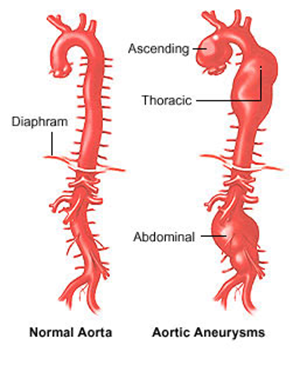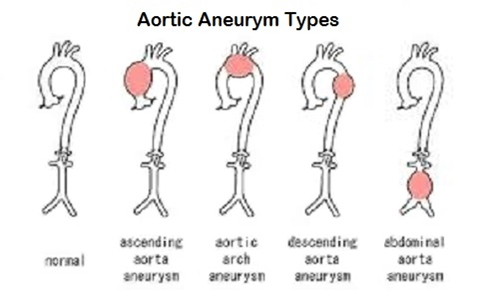Page History
...
Types of Aortic Aneurysm
Renal Artery Aneurysm
There are many ways to ask if someone has an aneurysm. If the person has prior history of a particular type of aneurysm, say, aortic aneurysm, and the physician suspects that the patient suffers from another one, then specialized imaging instruments that are location-specific can be used. Examples are TRANSESOPHAGEAL ECHOCARDIOGRAPHY or TRANSTHORACIC ECHOCARDIOGRAPHY, they are used to look for abnormalities in the chest and in the abdomen. The original data elements provided to us by DUKE and ACC, from which we created the examples in the CV-imaging TAUG, whether a patient has an aneurysm is asked in a pre-specified fashion? Does the patient have:
Aortic aneurysm? Aortic arch aneurysm?
Abdominal aneurysm? etc.
However, often Often times when patients complain about chest discomforts and pain, it is hard the occurrence of aneurysm(s) are suspected. It is difficult to pinpoint the exact location of an the aneurysm hence . Hence MRI and CT scan are the most frequently used tools to detect aneurysmthe presence and location of aneurysms. In this casescenario, the test location is locations are often broadly defined as the subject's chest, abdominal cavity , or the whole - body. The specific location(s) where aneurysms are found are actually locations for the resultsidentified/found should be mapped to result location, not test.
| Dataset wrap | |||||||||||||||||||||||||||||||||||||||||||||||||||||||||||||||||||||||||||||||||||||||||||||||||||||||||||||||||||||||||||||||
|---|---|---|---|---|---|---|---|---|---|---|---|---|---|---|---|---|---|---|---|---|---|---|---|---|---|---|---|---|---|---|---|---|---|---|---|---|---|---|---|---|---|---|---|---|---|---|---|---|---|---|---|---|---|---|---|---|---|---|---|---|---|---|---|---|---|---|---|---|---|---|---|---|---|---|---|---|---|---|---|---|---|---|---|---|---|---|---|---|---|---|---|---|---|---|---|---|---|---|---|---|---|---|---|---|---|---|---|---|---|---|---|---|---|---|---|---|---|---|---|---|---|---|---|---|---|---|---|
| |||||||||||||||||||||||||||||||||||||||||||||||||||||||||||||||||||||||||||||||||||||||||||||||||||||||||||||||||||||||||||||||
|
From the CV-imaging project we also encountered use-cases where we need sub-LOC variables to help to further specify the free-text, detailed, more granular locations where a test is performed. These values are indeed clinically relevant location information that should NOT be pre-coordinated into the TEST itself, but are also inappropriate for LOC.
So we need a variable that provides additional, more specific and granular information about a proximate location or a range of location(s).
This example shows the minor axis cross-sectional diameter measurements of the left and right ventricle of the heart, at end ventricular diastole.
| Dataset wrap | |||||||||||||||||||||||||||||||||||||||||||||||||||||||||||||
|---|---|---|---|---|---|---|---|---|---|---|---|---|---|---|---|---|---|---|---|---|---|---|---|---|---|---|---|---|---|---|---|---|---|---|---|---|---|---|---|---|---|---|---|---|---|---|---|---|---|---|---|---|---|---|---|---|---|---|---|---|---|
| |||||||||||||||||||||||||||||||||||||||||||||||||||||||||||||
|
...
|



